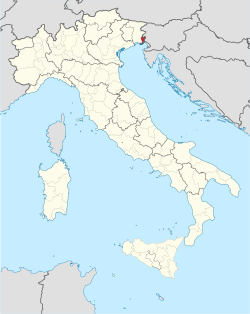Province of Gorizia
Regional decentralization entity of Gorizia | |
|---|---|
 Map highlighting the location of the province of Gorizia in Italy | |
| Country | |
| Region | Friuli–Venezia Giulia |
| Capital(s) | Gorizia |
| Comuni | 25 |
| Government | |
| • Commissar | Paolo Viola |
| Area | |
| • Total | 466 km2 (180 sq mi) |
| Population (31 June 2016) | |
| • Total | 139,902 |
| • Density | 300/km2 (780/sq mi) |
| GDP | |
| • Total | €3.656 billion (2015) |
| • Per capita | €26,007 (2015) |
| Time zone | UTC+1 (CET) |
| • Summer (DST) | UTC+2 (CEST) |
| Postal code | 34070-34079, 34170 |
| Telephone prefix | 0431, 0481 |
| ISO 3166 code | IT-GO |
| Vehicle registration | GO |
| ISTAT | 031 |
The province of Gorizia (Italian: provincia di Gorizia; Slovene: Goriška pokrajina; Friulian: provincie di Gurize) was a province in the autonomous Friuli-Venezia Giulia region of Italy. Initially disbanded on 30 September 2017, it was reestablished in 2019 as the regional decentralization entity of Gorizia (Italian: ente di decentramento regionale di Gorizia; Slovene: enota deželne decentralizacije Gorica; Friulian: ent di decentrament regjonâl di Gurize), and was reactivated on 1 July 2020.[2]
Overview
[edit]Its capital is the city of Gorizia. It belonged to the province of Udine between 1924 and 1927 and the communes of Sonzia, Plezzo, Bergogna, Caporetto, Tolmino, Circhina, Santa Lucia d'Isonzo, Gracova Serravalle, Canale d'Isonzo, Cal di Canale, Idria, Montenero d'Idria, Castel Dobra, Salona d'Isonzo, Gargaro, Chiapovano, Aidussina, Santa Croce di Aidùssina, Cernizza Goriziana, Tarnova della Selva, Sambasso, Merna, Ranziano, Montespino, Opacchiasella, Temenizza, Rifembergo, Comeno, San Daniele del Carso, Zolla, Vipacco, San Martino di Quisca and San Vito di Vipacco, as well as the eastern part of Gorizia, were part of this province between 1918–1924 and 1927–1947. These communes are now part of Slovenia.
It has an area of 466 square kilometres (180 sq mi) and a total population of 142,035 (2012). It has a coastal length of 47.6 kilometres (29.6 mi). There are 25 communes in the province.[3]
Around 11% of the population of the province is ethnically Slovenian.[4] Italian legislation ensures the protection of the Slovene linguistic minority in 9 of the 25 municipalities which comprise the province.[5] Three rural municipalities (Doberdò del Lago, Savogna d'Isonzo and San Floriano del Collio) have an ethnically Slovene majority, but the majority of native Slovene speakers in the province live in the urban area of Gorizia.
The top ten countries of origin of the inhabitants of Gorizia with foreign citizenship at 31 December 2010 were:[6]
 Croatia 1603
Croatia 1603 Romania 1153
Romania 1153 Slovenia 1092
Slovenia 1092 Bangladesh 851
Bangladesh 851 North Macedonia 799
North Macedonia 799 Serbia 646
Serbia 646 Bosnia and Herzegovina 502
Bosnia and Herzegovina 502 Kosovo 431
Kosovo 431 Albania 427
Albania 427 Ukraine 374
Ukraine 374
See also
[edit]References
[edit]- ^ Regions and Cities > Regional Statistics > Regional Economy > Regional Gross Domestic Product (Small regions TL3), OECD.Stats. Accessed on 16 November 2018.
- ^ "Focus sugli Enti di decentramento regionale". IlFriuli.it (in Italian). 22 September 2020. Retrieved 18 August 2023.
- ^ "Unione delle Province d'Italia (UPI)". Archived from the original on 2007-08-07. Retrieved 2020-03-12.
- ^ "UOC (Universitat Oberta de Catalunya)". www.uoc.edu. Retrieved Mar 12, 2020.
- ^ "Cip - Minoranze Linguistiche". Archived from the original on 2009-02-06. Retrieved 2009-11-21.
- ^ ISTAT. "Gorizia". ISTAT. Archived from the original on 2018-01-26. Retrieved 2012-06-06.
External links
[edit]- Official website (in Italian) (in Slovene)
45°56′23″N 13°37′24″E / 45.9398°N 13.6234°E



